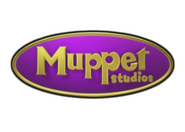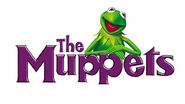Tag: Visual edit |
|||
| (25 intermediate revisions by 8 users not shown) | |||
| Line 1: | Line 1: | ||
| + | [[File:Eisner.henson.jpg|thumb|300px|August 28, 1989: Miss Piggy, Mickey Mouse, Michael Eisner, Jim Henson, and Kermit the Frog]] |
||
| − | [[File:WaltDisneyCompanylogo.png|thumb|300px|The Walt Disney Company's current corporate logo.]] |
||
| − | '''The Walt Disney Company''' is the largest media and entertainment |
+ | '''The Walt Disney Company''' is one of the largest media and entertainment companies in the world, known mainly for its family-friendly products. Founded in 1923 by brothers Walt Disney and Roy O. Disney as an animation studio, it has become one of the biggest [[Hollywood]] studios, and owner and licensor of eleven theme parks and several television networks, including [[ABC]] and [[ESPN]]. [[Mickey Mouse]] serves as the official mascot of The Walt Disney Company. |
| − | The company acquired [[:Category: The Muppets Characters|the Muppets]] and ''[[Bear in the Big Blue House]]'' |
+ | The company acquired the rights to [[:Category: The Muppets Characters|the Muppets]] and ''[[Bear in the Big Blue House]]'' characters from [[The Jim Henson Company]] in February 2004, forming [[#The Muppets Studio (2004-present)|The Muppets Studio, LLC]] (formerly Muppets Holding Company, LLC). |
==Early Disney/Henson attempts (1980s-1990)== |
==Early Disney/Henson attempts (1980s-1990)== |
||
| − | [[File: |
+ | [[File:1989_Disney_Henson_trade_ad.jpg|thumb|300px|1989 trade ad.]] |
| ⚫ | In 1984, [[Jim Henson]] considered purchasing the Disney company, which at the time was run by Ron Miller and under the threat of a hostile takeover by corporate raider Saul Steinberg. The idea never went further than inquiries, but after [[Michael Eisner]], Frank Wells and Jeffrey Katzenberg took over management of Disney, the idea of a Disney/Henson pairing was revived. Due to lack of activity with the Muppets after ''[[The Muppet Show]]''’s run, Disney decided to pass on a merger.<ref>[[Bernie Brillstein]], ''[[Where Did I Go Right?]]'', p.327</ref> |
||
| − | [[File:WaltDisneyPictures.png|thumb|300px|Walt Disney Pictures logo as it appeared from 1985 until 2006, as attached to ''The Muppet Christmas Carol'' and ''Muppet Treasure Island''.]] |
||
| ⚫ | In |
||
Another aspect that made the deal unattractive for Eisner was that the ''[[Sesame Street]]'' franchise was untouchable. [[Joan Ganz Cooney]] recalled that "In the end... at the end of his life, when he was being pursued by Disney, and very close to being bought by Disney... they had tried to get control of the ''Sesame Street'' product as well as the Muppet franchise, and Jim said 'that's a deal breaker'... they should remain entirely separate... He said to me 'I intend to leave with you... in my will.' He wanted it to go on in perpetuity." <ref>[http://www.timetravelispossible.com/ourradioprograms.html Interview: "Time Travel with Dan Hollis & Jeff O'Boyle"]</ref> |
Another aspect that made the deal unattractive for Eisner was that the ''[[Sesame Street]]'' franchise was untouchable. [[Joan Ganz Cooney]] recalled that "In the end... at the end of his life, when he was being pursued by Disney, and very close to being bought by Disney... they had tried to get control of the ''Sesame Street'' product as well as the Muppet franchise, and Jim said 'that's a deal breaker'... they should remain entirely separate... He said to me 'I intend to leave with you... in my will.' He wanted it to go on in perpetuity." <ref>[http://www.timetravelispossible.com/ourradioprograms.html Interview: "Time Travel with Dan Hollis & Jeff O'Boyle"]</ref> |
||
| − | Jim Henson again had a desire to sell the company to Disney in 1989, and this time Michael Eisner was more willing to buy the company without getting the rights to the ''Sesame Street'' cast (though Eisner did still want to have the rights to the ''Sesame Street'' Muppets).<ref>Davis, Michael ''[[Street Gang]]'', page 6.</ref> |
+ | Jim Henson again had a desire to sell the company to Disney in 1989, and this time Michael Eisner was more willing to buy the company without getting the rights to the ''Sesame Street'' cast (though Eisner did still want to have the rights to the ''Sesame Street'' Muppets).<ref>Davis, Michael ''[[Street Gang]]'', page 6.</ref> However, since Kermit was so much like Henson, he did not intend on including Kermit unconditionally, feeling that he should continue having control over the use of Kermit, which The Walt Disney Company would not agree with. <ref>''[[Jim Henson: The Biography]]'' by [[Brian Jay Jones]], page 446.</ref> |
| − | On August 28, 1989, Disney and Henson officially entered a merger agreement reportedly valued at $ |
+ | On August 28, 1989, Disney and Henson officially entered a merger agreement reportedly valued at $150 million. The deal included, in addition to Henson's characters and film and television library, a fifteen-year contract for Jim Henson's personal "creative services." In May 1990, the deal was near completion when Jim Henson unexpectedly passed away at the age of 53. By the following December, the two sides could not come to terms, and the merger was called off. |
==After Henson's death (1990-2004)== |
==After Henson's death (1990-2004)== |
||
| Line 19: | Line 18: | ||
[[File:DISNEY_MEMORIAL.jpg|thumb|300px|Memorial by Disney artist and animator Don 'Ducky' Williams]] |
[[File:DISNEY_MEMORIAL.jpg|thumb|300px|Memorial by Disney artist and animator Don 'Ducky' Williams]] |
||
Many projects were planned; however due to Henson's untimely death, very few came to fruition. Among the Disney/Henson collaborations that have been seen are the 1990 special ''[[The Muppets at Walt Disney World]]'' (one of the few collaborations to be released before Henson's passing), the stage show ''[[Here Come the Muppets]]'', and the theme park attraction/film ''[[Muppet*Vision 3D]]''. Among the projects that were made but never shown to the public are the proposed TV series ''[[Little Mermaid's Island]]'' for [[Disney Channel]], and a segment for ''The Mickey Mouse Club'' about puppeteering (this sequence was filmed while Jim Henson was making ''Muppet*Vision 3D''). Also in development were several theme park attractions, including [[The Great Muppet Movie Ride]] and [[The Great Gonzo's Pandemonium Pizza Parlor]], and a Muppet takeover of [[Disneyland]], renaming it [[Muppetland]], which were abandoned once the Disney/Henson deal dissolved. The Jim Henson Company also produced ''[[Mother Goose Stories]]'', an original series for Disney Channel, which did not air until after Henson's death. Jim Henson had also pitched the series ''[[Dinosaurs]]'', which Disney developed and released after Henson died. |
Many projects were planned; however due to Henson's untimely death, very few came to fruition. Among the Disney/Henson collaborations that have been seen are the 1990 special ''[[The Muppets at Walt Disney World]]'' (one of the few collaborations to be released before Henson's passing), the stage show ''[[Here Come the Muppets]]'', and the theme park attraction/film ''[[Muppet*Vision 3D]]''. Among the projects that were made but never shown to the public are the proposed TV series ''[[Little Mermaid's Island]]'' for [[Disney Channel]], and a segment for ''The Mickey Mouse Club'' about puppeteering (this sequence was filmed while Jim Henson was making ''Muppet*Vision 3D''). Also in development were several theme park attractions, including [[The Great Muppet Movie Ride]] and [[The Great Gonzo's Pandemonium Pizza Parlor]], and a Muppet takeover of [[Disneyland]], renaming it [[Muppetland]], which were abandoned once the Disney/Henson deal dissolved. The Jim Henson Company also produced ''[[Mother Goose Stories]]'', an original series for Disney Channel, which did not air until after Henson's death. Jim Henson had also pitched the series ''[[Dinosaurs]]'', which Disney developed and released after Henson died. |
||
| − | |||
| ⚫ | Throughout the 1990s The Jim Henson Company partnered with Disney. The Walt Disney Company produced and released ''[[The Muppet Christmas Carol]]'' and ''[[Muppet Treasure Island]]'', the first two Muppet movies made after Jim Henson died, and for a time in the early '90s, controlled the video release rights to ''[[The Muppet Movie]]'', ''[[The Great Muppet Caper]]'', episodes of ''[[Fraggle Rock]]'' and ''[[Muppet Babies]]'', and other properties, released through their Buena Vista Home Entertainment label (under a label titled [[Jim Henson Video]]). In addition, Walt Disney Home Video released a number of ''Sesame Street'' videos in the [[United Kingdom|UK]]. ''[[Muppets Tonight]]'' was also produced for the Disney-owned [[ABC|ABC network]] and Disney Channel. Disney also produced ''Bear in the Big Blue House'' with The Jim Henson Company for Disney Channel. |
||
All the character illustrators at [[Walt Disney World]] were asked to create concept sketches to choose from for the condolence card to be presented to the Henson family from Walt Disney World. Each artist created several. |
All the character illustrators at [[Walt Disney World]] were asked to create concept sketches to choose from for the condolence card to be presented to the Henson family from Walt Disney World. Each artist created several. |
||
| + | |||
| ⚫ | Throughout the 1990s The Jim Henson Company partnered with Disney. The Walt Disney Company produced and released ''[[The Muppet Christmas Carol]]'' and ''[[Muppet Treasure Island]]'', the first two Muppet movies made after Jim Henson died, and for a time in the early '90s, controlled the video release rights to ''[[The Muppet Movie]]'', ''[[The Great Muppet Caper]]'', episodes of ''[[Fraggle Rock]]'' and ''[[Muppet Babies]]'', and other properties, released through their Buena Vista Home Entertainment label (under a label titled [[Jim Henson Video]]). In addition, Walt Disney Home Video released a number of ''Sesame Street'' videos in the [[United Kingdom|UK]]. ''[[Muppets Tonight]]'' was also produced for the Disney-owned [[ABC|ABC network]] and Disney Channel. Disney also produced ''Bear in the Big Blue House'' with The Jim Henson Company for Disney Channel. |
||
==Disney acquires the Muppets (2004)== |
==Disney acquires the Muppets (2004)== |
||
| Line 30: | Line 29: | ||
The Walt Disney Company and The Jim Henson Company announced on February 17, 2004 that they had entered into an agreement under which Disney would acquire the Muppets and ''Bear in the Big Blue House'' properties from Henson. The parties signed a binding purchase agreement, with the transaction closing in April 2004 after receiving the necessary regulatory clearances. |
The Walt Disney Company and The Jim Henson Company announced on February 17, 2004 that they had entered into an agreement under which Disney would acquire the Muppets and ''Bear in the Big Blue House'' properties from Henson. The parties signed a binding purchase agreement, with the transaction closing in April 2004 after receiving the necessary regulatory clearances. |
||
| − | The transaction included all Muppet assets, including the [[Kermit the Frog]], [[Miss Piggy]], [[Fozzie Bear]], [[Gonzo]] and [[Animal]] characters, the Muppet film and television library, and all associated copyrights and trademarks, as well as all the ''Bear in the Big Blue House'' characters, television library, copyrights and trademarks. The transaction did not include the ''Sesame Street'' characters, which are separately owned by [[Sesame Workshop]], nor did it include ''[[Fraggle Rock]]'' and other franchises, which The Jim Henson Company retained. The deal also included non-exclusive production and consulting agreements under which Henson would develop potential new programming featuring the Muppets and ''Bear in the Big Blue House'' for Disney. Sesame Workshop has permission from Disney to use old Kermit segments from ''Sesame Street'' in new DVD releases |
+ | The transaction included all Muppet assets, including the [[Kermit the Frog]], [[Miss Piggy]], [[Fozzie Bear]], [[Gonzo]] and [[Animal]] characters, the Muppet film and television library, and all associated copyrights and trademarks, as well as all the ''Bear in the Big Blue House'' characters, television library, copyrights and trademarks. The transaction did not include the ''Sesame Street'' characters, which are separately owned by [[Sesame Workshop]], nor did it include ''[[Fraggle Rock]]'' and other franchises, which The Jim Henson Company retained. The deal also included non-exclusive production and consulting agreements under which Henson would develop potential new programming featuring the Muppets and ''Bear in the Big Blue House'' for Disney. Sesame Workshop has permission from Disney to use old Kermit segments from ''Sesame Street'' in new DVD releases and online. Kermit also make a cameo appearance on [[Elmo's World: Frogs]] and has appeared on the cover of ''Sesame Street'' DVDs such as ''[[Silly Storytime]]'' and ''[[Best of Sesame Street Spoofs!]]''. [[Lionsgate]] got permission from Disney to use the Muppets characters on the 2010 DVD releases of ''[[Henson's Place]]'', ''[[Sesame Street: 20 and Still Counting]]'', and ''[[Dog City: The Movie]]''. |
| − | |||
| − | ''[[The Muppets' Wizard of Oz]]'' has a reference to Disney buying the Muppets. In one scene, [[Toto]] is shown talking on his cell phone with Micheal Eisner saying, "If you think we're going for that deal, you're out of your Mickey mind, okay." |
||
==The Muppets Studio (2004-present)== |
==The Muppets Studio (2004-present)== |
||
[[File:TheMuppetsStudio.jpg|thumb|300px|The Muppets Studio logo]] |
[[File:TheMuppetsStudio.jpg|thumb|300px|The Muppets Studio logo]] |
||
[[Image:Muppets2011Trailer02-01.jpg|thumb|300px|[[Kermit the Frog|Kermit]] and [[Animal]] in front of the Disney logo as seen in [[The Muppets Second Official Trailer|the second trailer]] for ''The Muppets'']] |
[[Image:Muppets2011Trailer02-01.jpg|thumb|300px|[[Kermit the Frog|Kermit]] and [[Animal]] in front of the Disney logo as seen in [[The Muppets Second Official Trailer|the second trailer]] for ''The Muppets'']] |
||
| + | [[Image:Producer.curtin.jpg|frame|Muppets Holding Company VP and General Manager Chris Curtin with [[Pepe the King Prawn]] at a Disney properties conference discussing upcoming projects for the Muppets on July 11th, 2005.]] |
||
| − | '''The Muppets Studio, LLC''' (formerly Muppets Holding Company, LLC) is a wholly-owned subsidiary of The Walt Disney Company. It was formed in February 2004 after Disney acquired |
+ | '''The Muppets Studio, LLC''' (formerly Muppets Holding Company, LLC) is a wholly-owned subsidiary of The Walt Disney Company. It was formed in February 2004 after Disney acquired the rights to [[:Category: The Muppets Characters|the Muppets]] and [[:Category: Bear in the Big Blue House Characters|''Bear in the Big Blue House'' characters]] from [[The Jim Henson Company]]. The company manages the use of the Muppets characters and trademarks and serves as the production house for many Muppet projects. Since February 2006, the Muppets characters have been built and maintained by the [[Puppet Heap|Puppet Heap Workshop]]. |
| − | The Muppets Studio has been managed by |
+ | The Muppets Studio has been managed by Chris Curtin (February 2004 - October 2005), Russell Hampton (4th quarter of 2005-2006) and [[Lylle Breier]] (2006-present). When the Muppets were first transferred to Disney, the division had only two employees.<ref>Setoodeh, Ramin. "[http://variety.com/2014/film/news/the-muppets-talk-about-comebacks-and-their-relationship-with-disney-1201128921/ How Kermit and the Muppets Got Their Mojo Back]", ''[[Variety]]'', March 11, 2014</ref> |
| − | The first major production of The Muppets Studio was ''[[The Muppets' Wizard of Oz]]'', a television movie that was already in development with [[ABC]]prior to Disney's purchase of the Muppets. |
+ | The first major production of The Muppets Studio was ''[[The Muppets' Wizard of Oz]]'', a television movie that was already in development with [[ABC]] prior to Disney's purchase of the Muppets. |
| ⚫ | |||
| + | The Muppets Studio logo became the signature on productions of the company; web series such as ''[[From the Balcony]]'' and ''[[The Muppets Kitchen with Cat Cora]]'', television specials like ''[[Studio DC: Almost Live]]'' on [[Disney Channel]], and ''[[A Muppets Christmas: Letters to Santa]]'' which aired on [[NBC]]. The logo was also added to home video releases by Buena Vista Home Entertainment (including ''[[The Muppet Show]]'' season box sets, Kermit's 50th Anniversary Edition DVDs, and other Muppet titles). |
||
| ⚫ | In 2007, The Muppets Studio collaborated with Walt Disney Imagineering to create the [[Muppet Mobile Lab]]. In 2009, the company launched an official [[YouTube]] channel, a promotional [[Twitter]] feed, and an official [[Facebook]] page. In late 2009-early 2010, the Muppets were featured in the [[Give a Day. Get a Disney Day.]] campaign for [[Disneyland]] and [[Walt Disney World]]. In 2012, an interactive game featuring the Muppets, [[The Case of the Stolen Show]], debuted aboard the newest [[Disney Cruise Line|Disney Cruise]] ship, the Disney Fantasy. |
||
| ⚫ | |||
| + | |||
| ⚫ | |||
| + | In 2011, a new theatrical Muppet movie was released through Walt Disney Pictures, entitled ''[[The Muppets (2011)|The Muppets]]''. This was followed by a sequel, ''[[Muppets Most Wanted]]'', released by Disney in 2014. |
||
| + | |||
| ⚫ | |||
| ⚫ | |||
Image:MuppetStudios-black.png |
Image:MuppetStudios-black.png |
||
Image:Logo-muppets-disney-sm.jpg |
Image:Logo-muppets-disney-sm.jpg |
||
| Line 54: | Line 56: | ||
==References== |
==References== |
||
| + | [[File:Variety Rich and Famous ad.jpg|thumb|300px|"Walt Disney"]] |
||
| − | [[Image:labyrinth-disneyhood.jpg|frame|Disney's Robin Hood in Sarah's scrapbook, from ''Labyrinth'']] |
||
| − | [[Image: |
+ | [[Image:labyrinth-disneyhood.jpg|thumb|300px|Disney's Robin Hood in Sarah's scrapbook, from ''Labyrinth'']] |
| + | [[Image:WaltDizzy.jpg|thumb|300px|''<nowiki>Sesame Street'</nowiki>''s parody of Disney, MGM and Warner Bros.]] |
||
[[Image:AcademyAwards2012b.jpg|thumb|300px|Miss Piggy and Kermit at the 2012 Academy Awards in front of a picture of Walt Disney holding some of his Oscars.]] |
[[Image:AcademyAwards2012b.jpg|thumb|300px|Miss Piggy and Kermit at the 2012 Academy Awards in front of a picture of Walt Disney holding some of his Oscars.]] |
||
Before The Walt Disney Company bought the Muppets, there had been a number of references in Muppet/Henson projects to Disney and its productions and characters. In recent years, such references to Disney in Muppet productions have occurred as cross-promotion. The Muppets have also been referenced and have made appearances in Disney projects as well. |
Before The Walt Disney Company bought the Muppets, there had been a number of references in Muppet/Henson projects to Disney and its productions and characters. In recent years, such references to Disney in Muppet productions have occurred as cross-promotion. The Muppets have also been referenced and have made appearances in Disney projects as well. |
||
| − | *A number of songs from Disney movies have been sung on ''The Muppet Show'', including "[[Never Smile at a Crocodile]]", "[[An Actor's Life For Me]]", "[[It's a Small World]]", "[[Zip-a-Dee-Doo-Dah]]", and "[[When You Wish Upon a Star]]". |
+ | *A number of songs from Disney movies have been sung on ''[[The Muppet Show]]'', including "[[Never Smile at a Crocodile]]", "[[An Actor's Life For Me]]", "[[It's a Small World]]", "[[Zip-a-Dee-Doo-Dah]]", and "[[When You Wish Upon a Star]]". |
| ⚫ | |||
| ⚫ | |||
| + | * In ''[[The Muppet Movie]]'', the "Rich and Famous" ad in ''[[Variety]]'' that [[Bernie the Agent]] shows to Kermit features a blurb about Walt Disney. |
||
| ⚫ | |||
| ⚫ | |||
| ⚫ | |||
* A ''Sesame Street'' sketch parodying ''[[The Lion King]]'' was introduced as a "Walt Dizzy Film," with a small [[Warner Bros.]]-like logo below, and an [[MGM]]-like circle with a [[Chickens|chicken]] in the spot of the studio's trademark lion. |
* A ''Sesame Street'' sketch parodying ''[[The Lion King]]'' was introduced as a "Walt Dizzy Film," with a small [[Warner Bros.]]-like logo below, and an [[MGM]]-like circle with a [[Chickens|chicken]] in the spot of the studio's trademark lion. |
||
| − | * In ''[[The Muppets' Wizard of Oz]]'', |
+ | * In ''[[The Muppets' Wizard of Oz]]'', [[Toto]] talks on his cell phone with [[Michael Eisner]] saying, "If you think we're going for that deal, you're out of your Mickey mind, okay." |
| + | |||
| + | * In ''The Muppets' Wizard of Oz'', the "Goofy Holler" is used when the [[Tin Thing]] falls through the Wizard's trap door. |
||
| + | |||
| ⚫ | |||
* In the ''Sesame Street'' [[Season 42]] press kit, [[Baby Bear]]'s "Monsterbook" profile lists one of his favorite songs as "Bare Necessities" from ''The Jungle Book''. |
* In the ''Sesame Street'' [[Season 42]] press kit, [[Baby Bear]]'s "Monsterbook" profile lists one of his favorite songs as "Bare Necessities" from ''The Jungle Book''. |
||
* In ''[[The Muppets (2011)|The Muppets]]'', after [['80s Robot]] drives the Muppets wildly down the street to [[The Muppet Theater]] to start the show, [[Kermit's car|their car]] drives past Disney's Soda Fountain and Studio Store. |
* In ''[[The Muppets (2011)|The Muppets]]'', after [['80s Robot]] drives the Muppets wildly down the street to [[The Muppet Theater]] to start the show, [[Kermit's car|their car]] drives past Disney's Soda Fountain and Studio Store. |
||
| + | |||
| + | * ''[[Disney Drive-On with The Muppets]]'' takes place at the Disney studio, with various references to Disney productions. |
||
For other references, connections, appearances, or mentions, see the following: |
For other references, connections, appearances, or mentions, see the following: |
||
:'''Disney animation''' |
:'''Disney animation''' |
||
| − | {| border=0 cellspacing=0 cellpadding=4 valign=top |
+ | {| border="0" cellspacing="0" cellpadding="4" valign="top" |
| − | |valign=top| |
+ | | valign="top" | |
*''[[Bambi]]'' |
*''[[Bambi]]'' |
||
*''[[Cinderella]]'' |
*''[[Cinderella]]'' |
||
| Line 91: | Line 100: | ||
*''[[The Lion King]]'' |
*''[[The Lion King]]'' |
||
*''[[The Little Mermaid]]'' |
*''[[The Little Mermaid]]'' |
||
| − | |valign=top| |
+ | | valign="top" | |
*[[Mickey Mouse]] |
*[[Mickey Mouse]] |
||
*''[[Peter Pan]]'' |
*''[[Peter Pan]]'' |
||
| Line 101: | Line 110: | ||
*''[[Who Censored Roger Rabbit?|Who Framed Roger Rabbit]]'' |
*''[[Who Censored Roger Rabbit?|Who Framed Roger Rabbit]]'' |
||
*[[Winnie the Pooh]] |
*[[Winnie the Pooh]] |
||
| + | *''[[Wreck-It Ralph]]'' |
||
|} |
|} |
||
:'''Disney TV''' |
:'''Disney TV''' |
||
| − | {| border=0 cellspacing=0 cellpadding=8 valign=top |
+ | {| border="0" cellspacing="0" cellpadding="8" valign="top" |
| − | |valign=top| |
+ | | valign="top" | |
*[[ABC]] |
*[[ABC]] |
||
*''[[Dancing with the Stars]]'' |
*''[[Dancing with the Stars]]'' |
||
| Line 112: | Line 122: | ||
*[[ESPN]] |
*[[ESPN]] |
||
*''[[Extreme Makeover: Home Edition]]'' |
*''[[Extreme Makeover: Home Edition]]'' |
||
| − | |valign=top| |
+ | | valign="top" | |
| + | *''[[Good Luck Charlie]]'' |
||
*''[[Hannah Montana]]'' |
*''[[Hannah Montana]]'' |
||
*''[[High School Musical]]'' |
*''[[High School Musical]]'' |
||
*''[[Live!]]'' |
*''[[Live!]]'' |
||
*''[[Lost]]'' |
*''[[Lost]]'' |
||
| ⚫ | |||
*''[[The Mickey Mouse Club]]'' |
*''[[The Mickey Mouse Club]]'' |
||
*[[Playhouse Disney]] |
*[[Playhouse Disney]] |
||
| ⚫ | |||
*''[[Scrubs]]'' |
*''[[Scrubs]]'' |
||
*''[[So Random!]]'' |
*''[[So Random!]]'' |
||
| Line 126: | Line 137: | ||
:'''Disney Movies''' |
:'''Disney Movies''' |
||
| − | {| border=0 cellspacing=0 cellpadding=8 valign=top |
+ | {| border="0" cellspacing="0" cellpadding="8" valign="top" |
| − | |valign=top| |
+ | | valign="top" | |
*''[[Mary Poppins]]'' |
*''[[Mary Poppins]]'' |
||
*''[[Pirates of the Caribbean]]'' |
*''[[Pirates of the Caribbean]]'' |
||
*''[[The Country Bears]]'' |
*''[[The Country Bears]]'' |
||
| − | |valign=top| |
+ | | valign="top" | |
*''[[The Lion, the Witch, and the Wardrobe]]'' |
*''[[The Lion, the Witch, and the Wardrobe]]'' |
||
*''[[Wild Hogs]]'' |
*''[[Wild Hogs]]'' |
||
| Line 137: | Line 148: | ||
:'''Publications''' |
:'''Publications''' |
||
| − | {| border=0 cellspacing=0 cellpadding=8 valign=top |
+ | {| border="0" cellspacing="0" cellpadding="8" valign="top" |
| − | |valign=top| |
+ | | valign="top" | |
*''[[Disney Adventures]]'' |
*''[[Disney Adventures]]'' |
||
*[[The Disney Channel Magazine]] |
*[[The Disney Channel Magazine]] |
||
| − | |valign=top| |
+ | | valign="top" | |
*''[[Disney News]]'' |
*''[[Disney News]]'' |
||
*''[[Disney twenty-three]]'' |
*''[[Disney twenty-three]]'' |
||
| Line 147: | Line 158: | ||
:'''Theme parks''' |
:'''Theme parks''' |
||
| − | {| border=0 cellspacing=0 cellpadding=8 valign=top |
+ | {| border="0" cellspacing="0" cellpadding="8" valign="top" |
| − | |valign=top| |
+ | | valign="top" | |
*[[Disneyland]] |
*[[Disneyland]] |
||
*[[Walt Disney World]] |
*[[Walt Disney World]] |
||
| + | * [[Hong Kong Disneyland]] |
||
|} |
|} |
||
:'''Video games''' |
:'''Video games''' |
||
| − | {| border=0 cellspacing=0 cellpadding=8 valign=top |
+ | {| border="0" cellspacing="0" cellpadding="8" valign="top" |
| − | |valign=top| |
+ | | valign="top" | |
*''[[Disney Universe]]'' |
*''[[Disney Universe]]'' |
||
*''[[Just Dance: Disney Party]]'' |
*''[[Just Dance: Disney Party]]'' |
||
| Line 169: | Line 181: | ||
{{wikipedia}} |
{{wikipedia}} |
||
{{wikia|Disney}} |
{{wikia|Disney}} |
||
| + | [[File:Disney Wiki.png|right|link=w:c:disney]] |
||
* [http://www.disney.com/ Disney.com - official website] |
* [http://www.disney.com/ Disney.com - official website] |
||
* [http://thewaltdisneycompany.com/ Walt Disney Company corporate website] |
* [http://thewaltdisneycompany.com/ Walt Disney Company corporate website] |
||
Revision as of 11:47, 1 December 2014
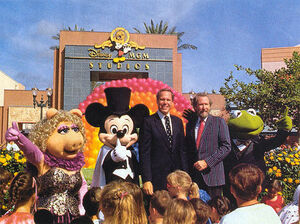
August 28, 1989: Miss Piggy, Mickey Mouse, Michael Eisner, Jim Henson, and Kermit the Frog
The Walt Disney Company is one of the largest media and entertainment companies in the world, known mainly for its family-friendly products. Founded in 1923 by brothers Walt Disney and Roy O. Disney as an animation studio, it has become one of the biggest Hollywood studios, and owner and licensor of eleven theme parks and several television networks, including ABC and ESPN. Mickey Mouse serves as the official mascot of The Walt Disney Company.
The company acquired the rights to the Muppets and Bear in the Big Blue House characters from The Jim Henson Company in February 2004, forming The Muppets Studio, LLC (formerly Muppets Holding Company, LLC).
Early Disney/Henson attempts (1980s-1990)
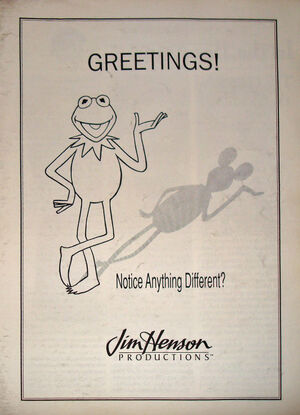
1989 trade ad.
In 1984, Jim Henson considered purchasing the Disney company, which at the time was run by Ron Miller and under the threat of a hostile takeover by corporate raider Saul Steinberg. The idea never went further than inquiries, but after Michael Eisner, Frank Wells and Jeffrey Katzenberg took over management of Disney, the idea of a Disney/Henson pairing was revived. Due to lack of activity with the Muppets after The Muppet Show’s run, Disney decided to pass on a merger.[1]
Another aspect that made the deal unattractive for Eisner was that the Sesame Street franchise was untouchable. Joan Ganz Cooney recalled that "In the end... at the end of his life, when he was being pursued by Disney, and very close to being bought by Disney... they had tried to get control of the Sesame Street product as well as the Muppet franchise, and Jim said 'that's a deal breaker'... they should remain entirely separate... He said to me 'I intend to leave with you... in my will.' He wanted it to go on in perpetuity." [2]
Jim Henson again had a desire to sell the company to Disney in 1989, and this time Michael Eisner was more willing to buy the company without getting the rights to the Sesame Street cast (though Eisner did still want to have the rights to the Sesame Street Muppets).[3] However, since Kermit was so much like Henson, he did not intend on including Kermit unconditionally, feeling that he should continue having control over the use of Kermit, which The Walt Disney Company would not agree with. [4]
On August 28, 1989, Disney and Henson officially entered a merger agreement reportedly valued at $150 million. The deal included, in addition to Henson's characters and film and television library, a fifteen-year contract for Jim Henson's personal "creative services." In May 1990, the deal was near completion when Jim Henson unexpectedly passed away at the age of 53. By the following December, the two sides could not come to terms, and the merger was called off.
After Henson's death (1990-2004)
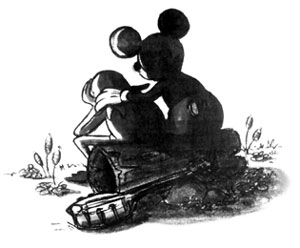
Memorial by Joe Lanzisero and Tim Kirk
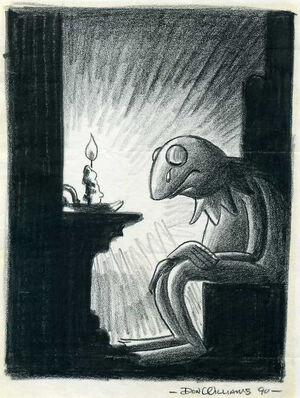
Memorial by Disney artist and animator Don 'Ducky' Williams
Many projects were planned; however due to Henson's untimely death, very few came to fruition. Among the Disney/Henson collaborations that have been seen are the 1990 special The Muppets at Walt Disney World (one of the few collaborations to be released before Henson's passing), the stage show Here Come the Muppets, and the theme park attraction/film Muppet*Vision 3D. Among the projects that were made but never shown to the public are the proposed TV series Little Mermaid's Island for Disney Channel, and a segment for The Mickey Mouse Club about puppeteering (this sequence was filmed while Jim Henson was making Muppet*Vision 3D). Also in development were several theme park attractions, including The Great Muppet Movie Ride and The Great Gonzo's Pandemonium Pizza Parlor, and a Muppet takeover of Disneyland, renaming it Muppetland, which were abandoned once the Disney/Henson deal dissolved. The Jim Henson Company also produced Mother Goose Stories, an original series for Disney Channel, which did not air until after Henson's death. Jim Henson had also pitched the series Dinosaurs, which Disney developed and released after Henson died.
All the character illustrators at Walt Disney World were asked to create concept sketches to choose from for the condolence card to be presented to the Henson family from Walt Disney World. Each artist created several.
Throughout the 1990s The Jim Henson Company partnered with Disney. The Walt Disney Company produced and released The Muppet Christmas Carol and Muppet Treasure Island, the first two Muppet movies made after Jim Henson died, and for a time in the early '90s, controlled the video release rights to The Muppet Movie, The Great Muppet Caper, episodes of Fraggle Rock and Muppet Babies, and other properties, released through their Buena Vista Home Entertainment label (under a label titled Jim Henson Video). In addition, Walt Disney Home Video released a number of Sesame Street videos in the UK. Muppets Tonight was also produced for the Disney-owned ABC network and Disney Channel. Disney also produced Bear in the Big Blue House with The Jim Henson Company for Disney Channel.
Disney acquires the Muppets (2004)
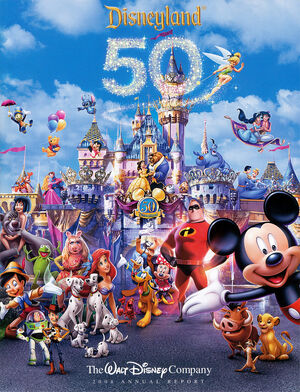
The Walt Disney Company welcomes the Muppets into the Disney family in the 2004 Annual Report.
The company acquired the Muppets and Bear in the Big Blue House franchises in 2004, forming Muppets Holding Company, LLC (later retitled The Muppets Studio, LLC).
The Walt Disney Company and The Jim Henson Company announced on February 17, 2004 that they had entered into an agreement under which Disney would acquire the Muppets and Bear in the Big Blue House properties from Henson. The parties signed a binding purchase agreement, with the transaction closing in April 2004 after receiving the necessary regulatory clearances.
The transaction included all Muppet assets, including the Kermit the Frog, Miss Piggy, Fozzie Bear, Gonzo and Animal characters, the Muppet film and television library, and all associated copyrights and trademarks, as well as all the Bear in the Big Blue House characters, television library, copyrights and trademarks. The transaction did not include the Sesame Street characters, which are separately owned by Sesame Workshop, nor did it include Fraggle Rock and other franchises, which The Jim Henson Company retained. The deal also included non-exclusive production and consulting agreements under which Henson would develop potential new programming featuring the Muppets and Bear in the Big Blue House for Disney. Sesame Workshop has permission from Disney to use old Kermit segments from Sesame Street in new DVD releases and online. Kermit also make a cameo appearance on Elmo's World: Frogs and has appeared on the cover of Sesame Street DVDs such as Silly Storytime and Best of Sesame Street Spoofs!. Lionsgate got permission from Disney to use the Muppets characters on the 2010 DVD releases of Henson's Place, Sesame Street: 20 and Still Counting, and Dog City: The Movie.
The Muppets Studio (2004-present)
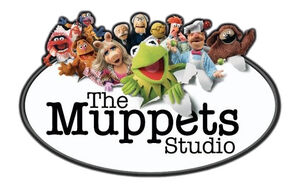
The Muppets Studio logo
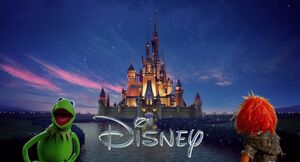
Kermit and Animal in front of the Disney logo as seen in the second trailer for The Muppets
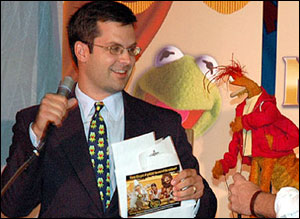
Muppets Holding Company VP and General Manager Chris Curtin with Pepe the King Prawn at a Disney properties conference discussing upcoming projects for the Muppets on July 11th, 2005.
The Muppets Studio, LLC (formerly Muppets Holding Company, LLC) is a wholly-owned subsidiary of The Walt Disney Company. It was formed in February 2004 after Disney acquired the rights to the Muppets and Bear in the Big Blue House characters from The Jim Henson Company. The company manages the use of the Muppets characters and trademarks and serves as the production house for many Muppet projects. Since February 2006, the Muppets characters have been built and maintained by the Puppet Heap Workshop.
The Muppets Studio has been managed by Chris Curtin (February 2004 - October 2005), Russell Hampton (4th quarter of 2005-2006) and Lylle Breier (2006-present). When the Muppets were first transferred to Disney, the division had only two employees.[5]
The first major production of The Muppets Studio was The Muppets' Wizard of Oz, a television movie that was already in development with ABC prior to Disney's purchase of the Muppets.
The Muppets Studio logo became the signature on productions of the company; web series such as From the Balcony and The Muppets Kitchen with Cat Cora, television specials like Studio DC: Almost Live on Disney Channel, and A Muppets Christmas: Letters to Santa which aired on NBC. The logo was also added to home video releases by Buena Vista Home Entertainment (including The Muppet Show season box sets, Kermit's 50th Anniversary Edition DVDs, and other Muppet titles).
In 2007, The Muppets Studio collaborated with Walt Disney Imagineering to create the Muppet Mobile Lab. In 2009, the company launched an official YouTube channel, a promotional Twitter feed, and an official Facebook page. In late 2009-early 2010, the Muppets were featured in the Give a Day. Get a Disney Day. campaign for Disneyland and Walt Disney World. In 2012, an interactive game featuring the Muppets, The Case of the Stolen Show, debuted aboard the newest Disney Cruise ship, the Disney Fantasy.
In 2011, a new theatrical Muppet movie was released through Walt Disney Pictures, entitled The Muppets. This was followed by a sequel, Muppets Most Wanted, released by Disney in 2014.
- Other logos
References
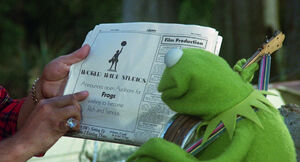
"Walt Disney"
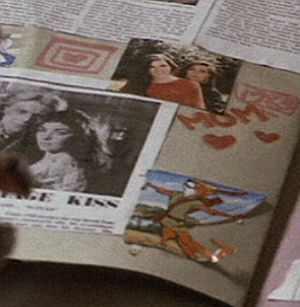
Disney's Robin Hood in Sarah's scrapbook, from Labyrinth
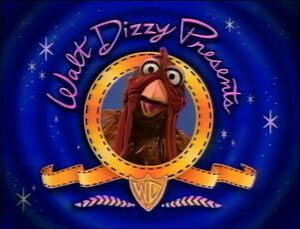
Sesame Street's parody of Disney, MGM and Warner Bros.
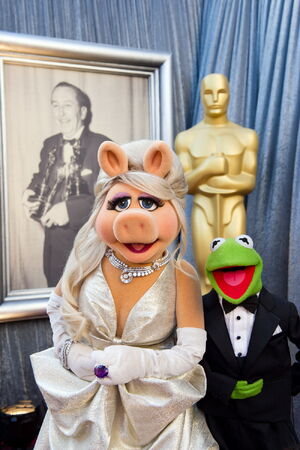
Miss Piggy and Kermit at the 2012 Academy Awards in front of a picture of Walt Disney holding some of his Oscars.
Before The Walt Disney Company bought the Muppets, there had been a number of references in Muppet/Henson projects to Disney and its productions and characters. In recent years, such references to Disney in Muppet productions have occurred as cross-promotion. The Muppets have also been referenced and have made appearances in Disney projects as well.
- A number of songs from Disney movies have been sung on The Muppet Show, including "Never Smile at a Crocodile", "An Actor's Life For Me", "It's a Small World", "Zip-a-Dee-Doo-Dah", and "When You Wish Upon a Star".
- In episode 320 of The Muppet Show, during the song "Let's Call the Whole Thing Off, after the lion sings "I like Plato and you like Pluto", Sylvester Stallone says "You can have Plato, and I'll stick with Pluto, and Mickey, and Goofy".
- In The Muppet Movie, the "Rich and Famous" ad in Variety that Bernie the Agent shows to Kermit features a blurb about Walt Disney.
- In Labyrinth, a panning shot of Sarah's scrapbook reveals an image of the fox version of Robin Hood, as seen in the 1973 Disney animated film. A book version of Disney's "Snow White and the Seven Dwarfs" can also be seen in Sarah's room.
- A Sesame Street sketch parodying The Lion King was introduced as a "Walt Dizzy Film," with a small Warner Bros.-like logo below, and an MGM-like circle with a chicken in the spot of the studio's trademark lion.
- In The Muppets' Wizard of Oz, Toto talks on his cell phone with Michael Eisner saying, "If you think we're going for that deal, you're out of your Mickey mind, okay."
- In The Muppets' Wizard of Oz, the "Goofy Holler" is used when the Tin Thing falls through the Wizard's trap door.
- On September 7, 2007, following Disney's purchase of the Muppets, a pin was released for sale only at Walt Disney World, featuring Kermit as Mickey Mouse, Miss Piggy as Minnie Mouse, Fozzie Bear as Goofy and Rizzo the Rat as Tinker Bell.
- In the Sesame Street Season 42 press kit, Baby Bear's "Monsterbook" profile lists one of his favorite songs as "Bare Necessities" from The Jungle Book.
- In The Muppets, after '80s Robot drives the Muppets wildly down the street to The Muppet Theater to start the show, their car drives past Disney's Soda Fountain and Studio Store.
- Disney Drive-On with The Muppets takes place at the Disney studio, with various references to Disney productions.
For other references, connections, appearances, or mentions, see the following:
- Disney animation
- Disney TV
- Disney Movies
- Publications
- Theme parks
- Video games
Sources
- ↑ Bernie Brillstein, Where Did I Go Right?, p.327
- ↑ Interview: "Time Travel with Dan Hollis & Jeff O'Boyle"
- ↑ Davis, Michael Street Gang, page 6.
- ↑ Jim Henson: The Biography by Brian Jay Jones, page 446.
- ↑ Setoodeh, Ramin. "How Kermit and the Muppets Got Their Mojo Back", Variety, March 11, 2014

